Hand Wash Delicate Fabrics: Silk, Lace, Wool and More
Silk is a luxurious and delicate fabric that requires special care to maintain its softness, sheen, and longevity. Washing silk incorrectly can lead to fading, shrinking, or fabric damage, so it’s essential to follow proper cleaning techniques.
Whether you choose to hand wash or use a gentle machine cycle, the right approach will help preserve your silk garments for years to come. This guide covers everything you need to know about washing silk safely, from choosing the right detergent to drying and storage tips.
1. Understanding delicate fabrics
This section will help you grasp what “delicate” really means when it comes to clothing and fabrics. It is important to have a foundational understanding of this before moving on to any washing procedures. We will be taking a look at common delicate fabric, their characteristics, and some hand washing tips.
| Fabric Name | Description | Characteristics | Hand Washing Tips |
|---|---|---|---|
| Silk | A natural protein fiber produced by silkworms. | Luxurious, smooth, lustrous, strong yet lightweight, drapes well. | Use cool water and a pH-neutral detergent. Avoid wringing or twisting. Lay flat or hang to dry, avoiding direct sunlight. |
| Lace | An openwork fabric with a decorative design. | Delicate, intricate, often sheer, can be made from various fibers (cotton, silk, etc.). | Use cool water and a gentle detergent. Handle with extreme care. Soak rather than scrub. Lay flat to dry. |
| Wool | A natural fiber from sheep. | Warm, insulating, moisture-wicking, can be prone to felting and shrinking. | Use cool or tepid water and a wool-specific detergent. Avoid agitation. Reshape and lay flat to dry. |
| Cashmere | A fine, soft fiber from the undercoat of cashmere goats. | Extremely soft, luxurious, lightweight, provides excellent insulation. | Use cool water and a cashmere-specific or gentle detergent. Avoid wringing. Reshape and lay flat to dry. |
| Rayon | A semi-synthetic fiber made from cellulose. | Drapes well, absorbent, can wrinkle easily, may shrink or stretch when wet. | Use cool water and a gentle detergent. Avoid wringing or twisting. Reshape and lay flat or hang to dry. |
| Chiffon | Lightweight plain woven fabric | Light and airy, great for warm temperatures. Can snag easily | Use cool water. Avoid wringing. Dry away from direct sunlight |
1.1 What makes a fabric “Delicate”?
Several things can make a fabric “delicate,” requiring gentle washing and careful fabric maintenance. It’s not just one single factor, but a combination:
- Fiber Type: Natural fibers like silk and wool are inherently more delicate than many synthetics. However, even some synthetics, like rayon, can be fragile when wet.
- Weave: A loose or open weave (think lace or a loosely knit sweater) is more prone to snagging, stretching, or distortion than a tight weave (like denim).
- Construction: Thin, sheer fabrics, or those with embellishments (beads, sequins, embroidery), require extra care because they’re more easily damaged.
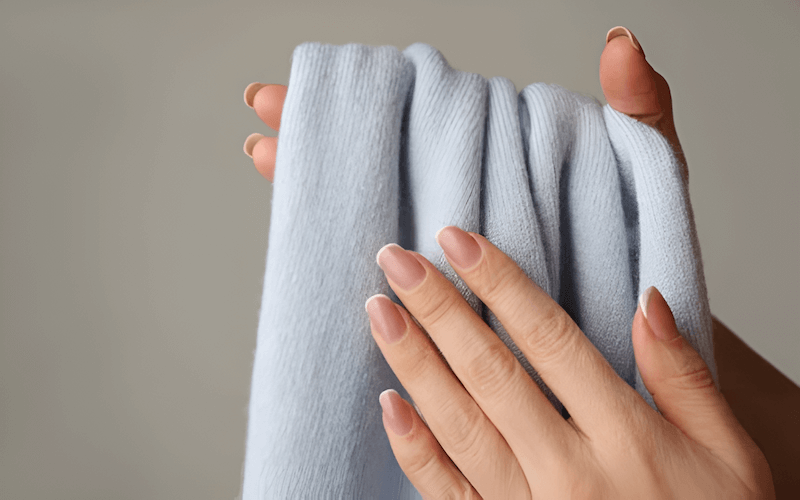
1.2 Common delicate fabrics and their characteristics
Understanding the specific properties of your garment’s fabric is key to choosing the right washing method.
- Silk: Known for its luxurious feel and beautiful drape, silk is a protein fiber that’s surprisingly strong when dry. However, it can weaken when wet and is susceptible to damage from high heat and harsh chemicals.
- Lace: This intricate, openwork fabric can be made from various fibers, including silk, cotton, or synthetics. Its delicate structure makes it prone to snagging and tearing.
- Wool: A natural fiber prized for its warmth and moisture-wicking properties, wool can felt (shrink and mat together) if exposed to hot water and agitation.
- Cashmere: An exceptionally soft and luxurious fiber, cashmere is even more delicate than wool and requires very gentle handling.
- Rayon: This semi-synthetic fabric is known for its drapability and absorbency. However, it can weaken, stretch, or shrink significantly when wet.
- Chiffon: This sheer, lightweight fabric is often made from silk, rayon, or polyester. It’s known for its airy, flowing drape, but it’s also very delicate and prone to snagging.
While some care labels might suggest a hand wash cycle in your washing machine as an option, hand washing is almost always the preferred method for these fabrics. It minimizes the risk of damage.
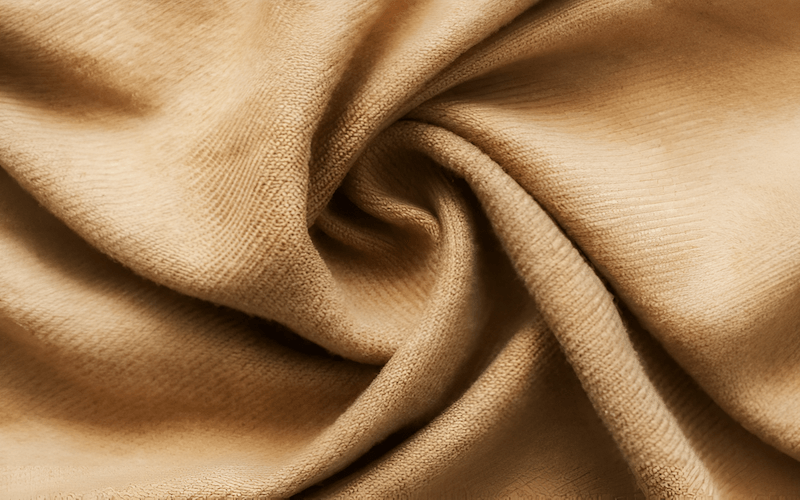
1.3 Reading care labels: Deciphering the symbols
Care labels are your best friend when it comes to caring for delicate garments. They provide vital information about how to wash, dry, and iron the item without causing damage. Here’s a breakdown of common symbols related to hand washing and dry cleaning:
| Symbol | Meaning |
|---|---|
| Basin with a hand | Hand wash only. |
| Basin with an X through it | Do not wash. |
| Circle | Dry clean only. |
| Circle with an X through it | Do not dry clean. |
| Circle with a letter (e.g., P, F) | Specifies the type of solvent that can be used during dry cleaning. |
| Triangle with an X | Do not bleach |
| Square with a circle in the middle, and an X | Do not tumble dry |
It is critical that these symbols are followed, to keep the integrity of these garments.
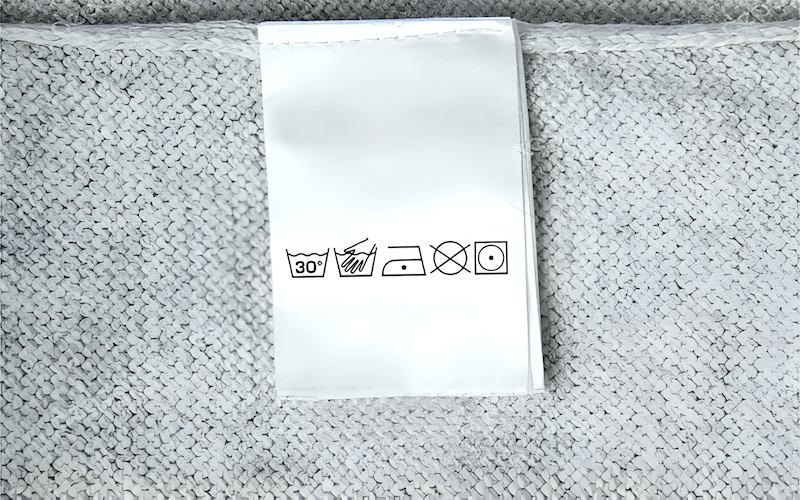
1.4 When to hand wash vs. dry clean (vs. machine wash)
Choosing the right washing method is crucial for preserving your delicate clothes. Here’s a guide:
- Hand Wash: This is the gentlest method and is recommended for most delicate fabrics, including silk, lace, wool, cashmere, and rayon. It allows for maximum control over water temperature, agitation, and detergent.
- Dry Clean: This process uses chemical solvents instead of water to clean clothes. It’s often recommended for items that are structured (like tailored suits), heavily embellished, or made from fabrics that are highly sensitive to water (like some silks and wools). While resources like The Laundress and Clothes Doctor offer tips on at-home care, dry cleaning is often the safest option for these items.
- Machine Wash: Even on a gentle or delicate cycle, machine washing can be too harsh for many delicate fabrics. The agitation, spinning, and potential for snagging on other garments can cause damage. Reserve machine washing for sturdier fabrics, and always use a mesh laundry bag for added protection. If the care label explicitly allows machine washing, follow the instructions carefully, but hand washing is still generally preferred for true delicates. Avoiding damage should always be the priority.
2. Before you wash: Essential preparations
This part is just as crucial as the washing process itself. Taking the right steps before you even turn on the tap can significantly impact the outcome and help preserve your delicate garments. Neglecting these preparatory actions can lead to less effective cleaning, increased risk of damage, and a shorter lifespan for your favorite clothes.
2.1 Check clothes carefully
Before you begin, inspect each item carefully. Look for any existing damage, such as loose seams, snags, or missing embellishments. Pay close attention to areas with pleats or special structure, like tailored collars or cuffs.
These areas may require extra care during washing and drying to maintain their shape. If you find any damage, it’s often best to repair it before washing to prevent it from worsening. Note if the garment is new and unwashed.
2.2 Gathering your supplies
Having everything you need readily available will streamline the hand washing process and prevent unnecessary interruptions. Here’s a list of essential supplies, along with their purpose:
- Basin/Sink: A clean basin or sink provides a dedicated space for washing. Make sure it’s large enough to comfortably accommodate the garment without overcrowding.
- Mild Detergent: A gentle, pH-neutral detergent is crucial for protecting delicate fibers. Harsh chemicals can strip color, weaken fabric, and cause damage.
- Towels: Several clean, absorbent towels are needed for blotting excess water and for laying garments flat to dry.
- Drying Rack: A drying rack (preferably mesh or non-rusting) allows for airflow and even drying, preventing stretching and distortion.
- Stain Remover: A gentle stain remover specifically designed for delicate fabrics can be used to pre-treat stains before washing.
- Mesh Laundry Bag: While primarily used for machine washing, a mesh laundry bag can also be helpful for hand washing. It can contain delicate items, like lingerie or items with embellishments, preventing them from tangling or snagging during the washing process. This enhances overall clothing care.

2.3 Choosing the right detergent
The type of detergent you use is critical when washing delicate fabrics. Harsh chemicals, strong enzymes, and high pH levels can all damage delicate fibers, leading to fading, shrinkage, and weakening of the fabric.
- Mild Detergent: Look for detergents specifically labeled as “mild,” “gentle,” or “for delicates.” These formulas are typically pH-neutral and free of harsh chemicals.
- pH Level: A neutral pH (around 7) is ideal for delicate fabrics. Avoid alkaline detergents (high pH), which can be damaging.
- Enzymes: While enzymes are effective at breaking down stains, they can also damage protein-based fibers like silk and wool. Opt for an enzyme-free detergent for these fabrics. The enzyme-free detergent impact is significant in preserving the integrity of these materials.
- Low-Suds: High-sudsing detergents can be difficult to rinse out completely, leaving behind residue that can irritate skin and damage fabric. Choose a low-suds formula for easier rinsing.
2.4 Pre-treating stains (The right way)
Pre-treating stains on delicate fabrics requires a gentle approach. Avoid harsh scrubbing or aggressive stain removers, which can damage the fabric.
- Identify the Stain: Different types of stains may require different treatments.
- Choose a Gentle Stain Remover: Select a stain remover specifically designed for delicate fabrics. Stain Solution is one example of a product formulated for this purpose, but there are other options available. Always check the product label to ensure it’s suitable for the fabric you’re treating.
- Test for Colorfastness: Before applying the stain remover to the visible stain, test it on an inconspicuous area of the garment (like an inner seam) to ensure it doesn’t cause color fading or damage.
- Apply Gently: Apply a small amount of the stain remover to the stain and gently work it in with your fingers or a soft cloth. Avoid rubbing vigorously.
- Allow Time to Work: Let the stain remover sit for the recommended time (usually 5-15 minutes), but don’t let it dry completely.
- Rinse Thoroughly: After pre-treating, rinse the area thoroughly with cool water to remove all traces of the stain remover.
2.5 Sorting your delicates
Just like with regular laundry, sorting your delicates before washing is essential to prevent damage and maintain their color and integrity.
- Separate by Color: Divide your delicates into light colors and dark colors. This prevents color bleeding, where dyes from darker garments transfer to lighter ones.
- Separate by Fabric Type: Group similar fabrics together. For example, wash silks with silks, and woolens with woolens. This helps prevent damage from heavier fabrics rubbing against more delicate ones. It also allows you to use the most appropriate water temperature and detergent for each fabric type.
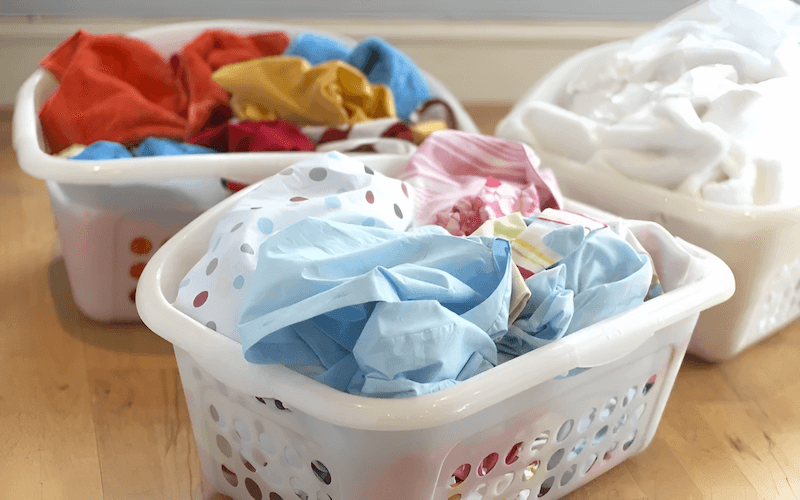
3. Step-by-step hand washing guide
This section provides a clear, step-by-step guide to hand washing your delicate garments. Following these instructions carefully will help ensure your clothes are cleaned effectively while minimizing the risk of damage.
3.1 Preparing the wash basin
Begin by thoroughly cleaning your sink or basin to remove any residue from soap, cleaning products, or food particles. Rinse it well. Then, fill the basin with the appropriate water temperature. For most delicate fabrics, cold water or tepid water (lukewarm) is best. Hot water can cause shrinkage, fading, or damage to delicate fibers.
3.2 Adding detergent
Add a small amount of mild detergent to the water. Generally, 1 teaspoon is sufficient for a small garment in a standard-sized sink. If you’re using a specific delicate wash product, refer to the product instructions for the recommended amount. Swirl the water gently with your hand to ensure the detergent dissolves completely before adding any clothing.

3.3 Submerging and soaking
Gently submerge the garment in the soapy water. Ensure it’s fully immersed. Allow the garment to soak for a period of time appropriate to the fabric and soil level. For lightly soiled items, 5-10 minutes may be sufficient. For more heavily soiled items, or for delicate fabrics like silk, a longer soak of up to 30 minutes may be beneficial.
3.4 Washing the garment
Gently agitate the garment in the water using a swishing motion. Avoid scrubbing, twisting, or wringing the fabric, as this can cause stretching, damage, or distortion. Focus on gently moving the water through the fabric to loosen dirt and grime. Pay particular attention to areas that may be more soiled, such as underarms or collars, but always maintain a gentle agitation. The goal is proper washing technique – effective cleaning without causing harm.
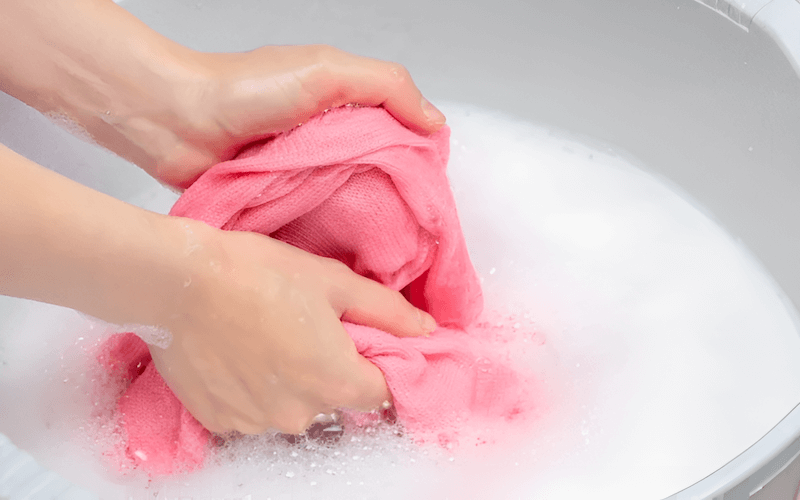
3.5 Rinsing thoroughly
Lift the garment from the soapy water and drain the basin. Refill the basin with clean cold water or tepid water. Gently submerge the garment and swish it around to rinse away the detergent. Repeat this process several times, changing the water each time, until all detergent residue is gone. Thorough rinsing is crucial because any remaining detergent can irritate skin, cause fabric stiffness, or even lead to discoloration over time.
3.6 Removing excess water
Carefully lift the garment from the rinse water. Avoid wringing or twisting, which can damage delicate fibers and distort the shape of the garment. Instead, gently press the garment between your hands or against the side of the basin to remove excess water. Then, lay the garment flat on a clean, absorbent towel. Roll the garment up in the towel, gently pressing to absorb excess water. You may need to repeat this process with a second dry towel if the garment is very wet.
4. Drying delicate fabrics
Proper drying is just as important as proper washing when it comes to caring for delicate fabrics. Incorrect drying methods can cause shrinkage, stretching, fading, and other forms of damage.
4.1 Reshaping the garment
Before drying, gently reshape the garment to its original form. This is especially important for knitwear, such as sweaters and cardigans, which can easily stretch or become misshapen when wet. Smooth out any wrinkles, straighten seams, and button or zip any closures. For items with structure, like collars or cuffs, gently mold them back into shape.

4.2 Flat drying vs. hanging
The best drying method depends on the fabric and the garment’s weight.
- Flat Drying: Laying a garment flat to dry is ideal for heavier items, like sweaters, and for items that are prone to stretching, such as knits and some delicate synthetics. This method prevents gravity from pulling on the wet fabric and causing distortion. Place the garment on a clean, dry, flat surface, such as a mesh drying rack or a clean towel.
- Hanging: Hanging is suitable for lightweight items, such as lingerie, silk blouses, and some dresses, provided they are not prone to stretching. Use padded hangers to prevent shoulder marks. Ensure the garment is hung evenly to avoid distortion. Extending garment life depends on choosing the correct method for each item.
4.3 Using a drying rack
A drying rack is a valuable tool for drying delicate fabrics. It allows for airflow around the garment, promoting even drying and preventing mildew.
- Mesh/Non-Rusting: Choose a drying rack made of mesh or a non-rusting material to prevent staining or damage to the fabric.
- Positioning: Position the garment on the rack to allow for maximum airflow. For sweaters, lay them flat across the rack. For other items, drape them evenly over the bars. Avoid overcrowding the rack, as this can restrict airflow and slow down drying.
4.4 Avoiding direct heat and sunlight
Direct heat and sunlight can be extremely damaging to delicate fabrics. They can cause shrinkage, fading, and weakening of the fibers.
- Direct Heat: Never use a clothes dryer on high heat for delicate items. Even low heat settings can be too harsh for some fabrics. Avoid placing garments near radiators, heaters, or other sources of direct heat.
- Sunlight: While sunlight can help dry clothes, direct sunlight can cause fading, especially in colored garments. Dry delicate items indoors or in a shaded area. Fabric preservation requires protecting garments from these damaging elements.
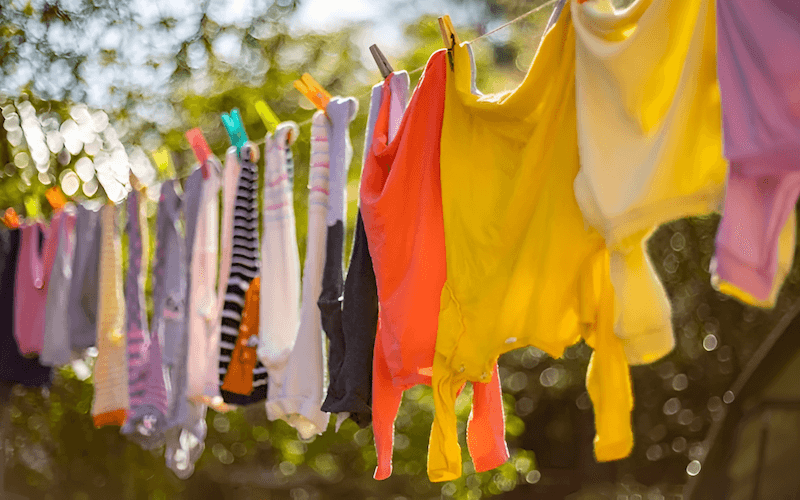
4.5 Speeding up drying time (safely)
While patience is key when drying delicates, there are ways to safely speed up the process.
- Ventilated Area: Place the drying rack in a well-ventilated area. Good airflow is essential for efficient drying.
- Fan: A fan can help circulate air and speed up drying time. Position the fan a safe distance from the garment and use a low setting to avoid excessive force. Efficient drying delicate clothes often involves a combination of these techniques.
5. Advanced techniques and troubleshooting
This section addresses common problems and provides solutions, along with some advanced techniques for caring for your delicate garments.
5.1 Dealing with difficult stains
Even with careful pre-treatment, some stains can be stubborn. Here are some tips for dealing with difficult stains on delicate fabrics:
- Ink Stain: For ink stains, try blotting the stain with rubbing alcohol (test on an inconspicuous area first). Apply the alcohol to a clean cloth and gently dab at the stain, working from the outside in. Avoid rubbing, which can spread the ink.
- Wine Stain: For red wine stains, immediately blot the stain with a clean cloth to absorb as much liquid as possible. Then, apply a paste of baking soda and water, or salt, to the stain. Let it sit for 30 minutes to an hour, then gently rinse.
- Oil Stain: For oil stains, sprinkle the stain with cornstarch or talcum powder to absorb the oil. Let it sit for at least 30 minutes, then brush off the powder. Pre-treat with a gentle stain remover or dish soap (test first) before hand washing.
Remember, stain removal on delicate fabrics always requires gentleness. Avoid harsh chemicals or vigorous scrubbing. Microplastic reduction can be achieved by using targeted stain removal techniques like these, rather than resorting to multiple washes, which can release more microplastics from synthetic fabrics.
5.2 Hand washing “dry clean only” items
Garments labeled “dry clean only” require careful consideration. Hand washing is sometimes possible, but it’s always at your own risk.
- Assess the Fabric: Some fabrics, like structured suits, heavily embellished items, and certain types of silk and wool, are best left to professional dry cleaners. Others, like some silks, rayons, and linens, may be hand washable.
- Test for Colorfastness: Before attempting to hand wash a “dry clean only” item, test for colorfastness. Dampen a clean, white cloth with cool water and gently rub it on an inconspicuous area of the garment (like an inner seam). If any color transfers to the cloth, the garment is not colorfast and should not be hand washed.
- Proceed with Caution: If the garment passes the colorfastness test, you can consider hand washing it, following the guidelines in this article. Use a very mild detergent, cool water, and minimal agitation. Be prepared for potential changes in texture or appearance.
5.3 Refreshing clothes between washes
To keep your clothes fresh and minimize the need for frequent washing, consider these tips:
- Air Out Garments: After wearing, hang clothes in a well-ventilated area to air out. This can help remove odors and reduce the need for washing.
- Spot Clean: Address small stains or spills immediately instead of washing the entire garment.
- Use Fabric Freshener: A fabric freshener spray can help neutralize odors and keep clothes smelling fresh between washes.
- Steaming: Steaming a piece of clothing can remove light wrinkles and also help to kill odor-causing bacteria
Refreshing clothes between washes is not only convenient but also helps to extend the life of your garments by reducing wear and tear from washing.
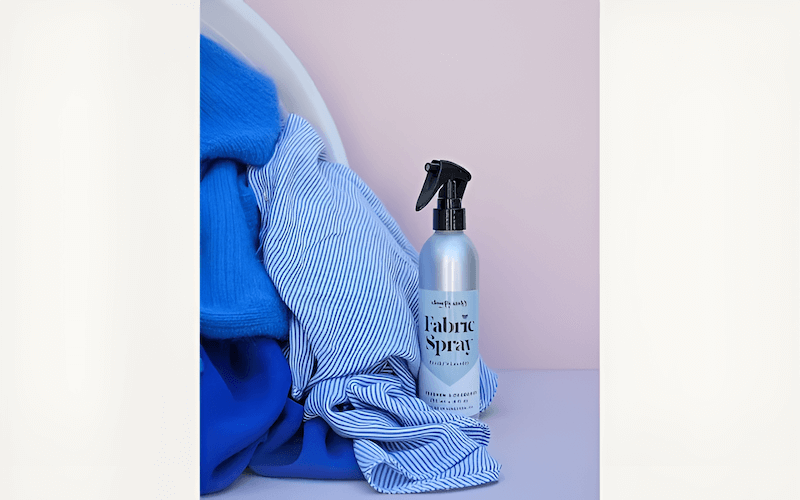
5.4 Storing delicate garments
Proper storage is essential for garment preservation.
- Clean Before Storing: Always store delicate garments clean. Dirt, sweat, and body oils can attract moths and other pests, and can cause stains and discoloration over time.
- Breathable Storage Bags: Use breathable storage bags made of cotton or muslin to protect garments from dust, light, and pests. Avoid plastic bags, which can trap moisture and lead to mildew.
- Avoid Overcrowding: Give garments plenty of space in your closet or drawers. Overcrowding can cause wrinkles, creases, and damage to delicate fabrics.
- Proper Folding/Hanging: Fold delicate knits and sweaters to prevent stretching. Hang items that are prone to wrinkling on padded hangers.
- Dark, Cool, Dry Place: Store delicate garments in a dark, cool, dry place to prevent fading, discoloration, and damage from humidity.
6. Related questions
This section addresses some frequently asked questions about caring for delicate clothes.
6.1 Can I use fabric softener on delicate clothes?
Generally, it’s not recommended to use fabric softener on delicate clothes. Fabric softeners can leave a residue on the fibers, which can reduce their breathability, affect their absorbency (especially for items like lingerie and activewear), and even damage some delicate materials like silk and wool. The residue can also build up over time, making the fabric feel less soft and potentially attracting dirt and odors.
6.2 How often should I hand wash my delicates?
The frequency of hand washing depends on the garment and how often it’s worn. Undergarments, like bras and underwear, should generally be washed after each wear. Other delicate items, like blouses, dresses, and sweaters, can often be worn multiple times before needing to be washed, unless they become visibly soiled or develop an odor. Consider factors like the fabric type, the climate, and your activity level.
6.3 What’s the best way to hand wash a silk scarf?
Hand washing a silk scarf requires extra care. Use cool water and a mild, pH-neutral detergent specifically designed for silk or delicates. Avoid hot water, harsh detergents, and bleach, which can damage the silk fibers. Gently submerge the scarf in the soapy water and let it soak for a few minutes (no more than 30).
Swish it gently, avoiding any scrubbing, wringing, or twisting. Rinse thoroughly with cool water until all detergent residue is gone. Gently press out excess water (don’t wring), and then roll the scarf in a clean towel to absorb more moisture. Lay the scarf flat to dry, away from direct sunlight or heat.
6.4 Is hand-washing really better for the environment?
Yes, in many ways, hand-washing is more environmentally friendly than machine washing. Hand-washing typically uses significantly less water than a washing machine, even on a delicate cycle. It also uses less energy, as you’re not powering a machine.
Furthermore, hand-washing can reduce microplastic shedding from synthetic fabrics. Microplastics are tiny plastic particles that are released when synthetic clothes are washed in a machine, and they can end up polluting waterways. Hand-washing’s gentler action reduces this shedding.
Read more:
Hand washing delicate fabrics might seem like a time-consuming task, but it’s an investment in the longevity and beauty of your favorite clothes. By understanding the principles of hand washing – gentle handling, appropriate detergents, and proper drying techniques – you can effectively clean your delicates while preserving their quality.
This not only extends the life of your garments, leading to cost savings in the long run, but also contributes to environmental friendliness by reducing water and energy consumption, and minimizing microplastic pollution.
Mastering the art of caring for delicates ensures that your cherished items, from delicate lace lingerie to luxurious cashmere sweaters, remain in pristine condition for years to come. Embrace the knowledge you’ve gained in this guide, and you’ll find that hand washing is not a chore, but a rewarding way to care for your delicate fabric and contribute to a more sustainable approach to laundry.
Visit our website https://mypacklove.com/ to explore our product options and request a quote. Contact us today to discuss your specific needs! Let us help you enhance your clothing care and branding efforts.






















